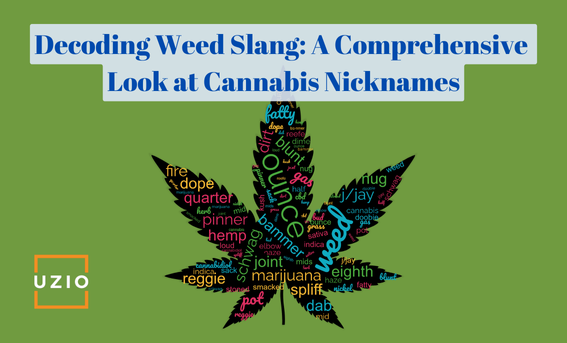
Cannabis Lingo: The Most Popular Weed Slang Terms Explained
Quick links
-
Introduction to Cannabis Slang
-
Slang Names vs. Actual Terms for Cannabis
-
The Most Popular Slang Terms for Cannabis
-
Cannabis Slang Terms from Around the World
-
Modern and Emerging Weed Slang
-
Slang Terms for Different Forms of Cannabis Consumption
-
Conclusion
1. Introduction to Cannabis Slang
Cannabis culture is rich with its own unique lexicon, a vibrant tapestry of slang and nicknames that have evolved over the years. These terms reflect the plant’s diverse history, its myriad uses, and its global journey through different societies and subcultures. Understanding this slang is not just about knowing what to call cannabis; it’s about appreciating the cultural significance and the evolution of the language surrounding this plant.
2. Slang Names vs. Actual Terms for Cannabis
While “weed,” “pot,” and other slang terms are widely recognized, it’s essential to differentiate these from the actual scientific and industry-standard terms for cannabis. Understanding both the colloquial and formal language surrounding cannabis can provide a more nuanced perspective on the plant and its uses.
Cannabis
Cannabis is the scientific term for the genus of flowering plants in the Cannabaceae family. This genus includes several species, but the two most commonly known are Cannabis sativa and Cannabis indica. Cannabis is used for its psychoactive properties, as well as for industrial purposes (hemp) and medicinal applications.
- Scientific Classification: Cannabis is classified under the plant family Cannabaceae. Its primary psychoactive component, tetrahydrocannabinol (THC), is responsible for the “high” associated with its use.
- Legal Terminology: In legal contexts, especially in states where cannabis is regulated, terms like “marijuana” and “cannabis” are used to differentiate between recreational and medicinal use. “Marijuana” often refers to the psychoactive drug used for recreational purposes, while “cannabis” can encompass both medicinal and recreational uses.
Indica and Sativa
Indica and Sativa are the two primary species of the cannabis plant, each with distinct characteristics and effects.
- Indica: Indica strains are typically associated with a relaxing, sedative effect. These plants are usually shorter and bushier, with broader leaves. Indica is often used for its calming effects, making it a popular choice for evening use or for managing conditions like anxiety and insomnia.
- Sativa: Sativa strains, on the other hand, are known for their uplifting and energizing effects. These plants are taller with narrower leaves. Sativa is often used during the day for its stimulating effects, which can help with focus, creativity, and combating depression.
Hemp and Cannabidiol (CBD)
Hemp and Cannabidiol (CBD) are terms that have gained significant attention, especially with the growing interest in non-psychoactive cannabis products.
- Hemp: Hemp refers to the industrial varieties of cannabis that are grown for their fiber and seeds, containing very low levels of THC (less than 0.3%). Hemp is used to produce a wide range of products, including textiles, paper, biofuels, and health foods.
- CBD: CBD is a non-psychoactive cannabinoid found in cannabis. Unlike THC, CBD does not produce a “high” and is widely used for its potential health benefits. Products containing CBD are used to manage conditions like chronic pain, epilepsy, and anxiety.
3. The Most Popular Slang Terms for Cannabis
Cannabis slang is as diverse and dynamic as the plant itself. These terms vary widely depending on regional influences, cultural contexts, and even the method of consumption. Here, we delve into some of the most popular and enduring slang terms for cannabis, exploring their origins and meanings.
Marijuana
Marijuana is one of the most commonly used terms for cannabis, especially in the United States. Its origins are believed to trace back to Mexican Spanish, with “marihuana” or “mariguana” being used to describe the cannabis plant. The term gained prominence in the early 20th century, especially during the anti-cannabis campaigns that linked the plant to Mexican immigrants, leading to its widespread adoption in American English.
Pot, Weed, Dope, Grass, Herb – The Old School Basics
These terms have been staples in the cannabis lexicon for decades and are still widely recognized today.
- Pot: The term “pot” is believed to be derived from the Spanish word “potiguaya,” a shortening of “potación de guaya,” which means a drink made from cannabis leaves.
- Weed: “Weed” is a straightforward slang term reflecting the plant-like nature of cannabis. It’s one of the most universally understood slang terms.
- Dope: “Dope” is a more general term that has been used to describe various drugs, including cannabis. Its use has declined somewhat due to its association with harder substances.
- Grass: “Grass” likely refers to the plant’s appearance, evoking its green, leafy characteristics.
- Herb: “Herb” emphasizes the natural, plant-based origin of cannabis and is often used in contexts that highlight its medicinal or holistic uses.
Reefer – A Really Old School Slang Term
Reefer is a term that gained popularity in the early 20th century, particularly in the jazz and swing subcultures. It was famously used in the 1936 propaganda film “Reefer Madness,” which depicted cannabis in a highly sensationalized and negative light. Despite its old-fashioned connotations, “reefer” remains a recognizable term.
Kush and Haze
Kush and Haze refer to specific strains of cannabis, each with its unique characteristics and cultural significance.
- Kush: Originating from the Hindu Kush mountain range in Afghanistan and Pakistan, Kush strains are known for their relaxing, sedative effects. The term “Kush” has become synonymous with high-quality, potent cannabis.
- Haze: Haze strains, known for their uplifting and energetic effects, trace their origins to a blend of sativa strains. The term “Haze” is often associated with creativity and focus.
Joint, J/Jay, Doobie, an L – All Will Get You to the Same Destination
These terms describe rolled cannabis cigarettes, which are among the most common methods of consumption.
- Joint: The most universal term for a rolled cannabis cigarette.
- J/Jay: A shorthand version of “joint.”
- Doobie: A more casual, perhaps slightly antiquated term for a joint.
- An L: Refers to the shape of a joint when rolled with a blunt wrap or sometimes just a regular joint.
A Pinner or a Fatty?
These terms describe the size and thickness of a rolled joint.
- Pinner: A thin, tightly rolled joint, often used when cannabis is in short supply.
- Fatty: A large, thick joint, indicating an ample supply of cannabis.
Spliff
A spliff is a rolled cigarette that contains a mixture of cannabis and tobacco. The term is more commonly used in European and Caribbean contexts, where mixing tobacco with cannabis is a common practice.
Blunt
A blunt is a cannabis cigar made by hollowing out a cigar or cigarillo and filling it with cannabis. The term originates from the Phillies Blunt brand of cigars, which were commonly used for this purpose.
Nug and Bud
These terms refer to the individual pieces of cannabis flower.
- Nug: A nugget of cannabis, typically a dense, high-quality piece.
- Bud: The flowering part of the cannabis plant that is harvested and consumed.
A Dime, Nickel, 20, or 30 Sack
These terms describe amounts of cannabis typically sold on the black market.
- Dime: $10 worth of cannabis, usually around a gram.
- Nickel: $5 worth of cannabis, approximately half a gram.
- 20 or 30 Sack: $20 or $30 worth of cannabis, with the quantity varying based on quality and market prices.
An Eighth, a Quarter, a Half Ounce, Ounce, a QP, an Elbow
These terms denote specific weights of cannabis.
- Eighth: An eighth of an ounce, approximately 3.5 grams.
- Quarter: A quarter of an ounce, roughly 7 grams.
- Half Ounce: 14 grams.
- Ounce: 28 grams.
- QP (Quarter Pound): 4 ounces or approximately 113 grams.
- Elbow: A slang term for a pound of cannabis, derived from “LB” (pound).
Schwag, Bammer, Dirt Weed, Reggie
These terms refer to low-quality cannabis, often characterized by poor appearance, low potency, and a rough smoking experience.
- Schwag: Low-grade cannabis that is dry, brittle, and contains seeds and stems.
- Bammer: Another term for poor-quality cannabis, commonly used on the West Coast.
- Dirt Weed: Self-explanatory, indicating very low-quality cannabis.
- Reggie: Short for “regular,” referring to mid-grade cannabis that is neither high-quality nor the worst.
Mid or Mids
Mid or Mids refer to mid-grade cannabis, which is average in quality and potency. It’s not the best, but it’s far from the worst.
Gas or Fire
These terms describe high-quality cannabis known for its potency and excellent effects.
- Gas: Indicates extremely potent, high-quality cannabis with a strong aroma.
- Fire: Another term for top-tier cannabis, suggesting it’s “hot” or desirable.
Loud
Loud refers to cannabis with a strong, pungent aroma, indicating high potency. It’s a term often used to describe the best quality cannabis.
Dab
A dab is a concentrated form of cannabis, typically consumed by vaporizing. The term “dabbing” refers to the method of consumption, which involves heating a small amount of concentrate on a hot surface and inhaling the vapor.
Stoned or Smacked
These terms describe the effects of consuming cannabis.
- Stoned: Feeling the sedative effects of cannabis, typically associated with indica strains.
- Smacked: Slang for feeling the potent effects of cannabis, often to the point of being heavily impaired.
420
420 is a widely recognized code for cannabis culture. It originated from a group of California high school students in the 1970s who would meet at 4:20 PM to smoke cannabis. Today, April 20th (4/20) is celebrated as an international cannabis culture day.
4. Cannabis Slang Terms from Around the World
Cannabis slang is as diverse as the cultures that use the plant, with each region developing its unique set of terms. These slang terms offer a fascinating glimpse into how cannabis is perceived and consumed globally. In this section, we’ll explore the various slang terms for cannabis from different parts of the world.
Jamaican Slang for Weed
Jamaica is renowned for its vibrant cannabis culture, deeply intertwined with Rastafarianism and reggae music. The most common Jamaican slang terms for cannabis include:
- Ganja: This term is derived from the Hindi word for cannabis, reflecting Jamaica’s historical connection with Indian laborers.
- Herb: Emphasizing the natural and sacred aspects of cannabis, “herb” is frequently used in Rastafarian contexts.
- Collie: Another term for cannabis, often used in reggae songs and Rastafarian circles.
Spanish Slang for Weed
In Spanish-speaking countries, cannabis slang varies widely, reflecting regional dialects and cultural nuances. Some common terms include:
- Marihuana: The formal term for cannabis in Spanish, widely recognized and used.
- Hierba: Literally translating to “herb,” this term is commonly used in Spain and Latin America.
- Mota: A popular slang term in Mexico, often used colloquially.
- Porro: Refers to a joint, especially in Spain.
British Slang for Weed
The UK has its own unique set of cannabis slang terms, influenced by both local culture and global trends. Common British terms include:
- Weed: Universally understood, this term is widely used in the UK.
- Skunk: Refers to high-potency cannabis, often associated with a strong odor.
- Bud: Similar to the American usage, referring to the flower of the cannabis plant.
- Spliff: A joint mixed with tobacco, a common method of consumption in the UK.
- Ganja: Borrowed from Jamaican culture, reflecting the UK’s diverse population.
African Slang for Weed
Africa’s cannabis slang is as diverse as its many cultures and languages. Some common terms include:
- Dagga: A term widely used in South Africa, originating from the Khoikhoi language.
- Bhang: Used in East Africa, reflecting Indian influence in the region.
- Mbanje: A term used in Zimbabwe and Zambia, referring to cannabis.
Indian Slang for Weed
India has a long history of cannabis use, with the plant deeply embedded in cultural and religious practices. Common Indian slang terms for cannabis include:
- Bhang: Refers to a preparation of cannabis leaves and flowers, often consumed as a drink during religious festivals.
- Ganja: Widely used across India, referring to the dried flowers of the cannabis plant.
- Charas: A form of hand-rubbed cannabis resin, similar to hashish, commonly used in Northern India and Nepal.
Recommended Reading: Rescheduling! Cannabis moving from schedule I to schedule III and what that means for taxes, companies and HR
5. Modern and Emerging Weed Slang
As cannabis continues to become more mainstream and legally accepted in many parts of the world, new slang terms are constantly emerging. These modern terms often reflect the evolving culture around cannabis, influenced by the internet, social media, and changing societal attitudes. Here, we’ll explore some of the latest trends in weed slang and how they’ve been shaped by contemporary influences.
New Trends in Cannabis Slang
The cannabis lexicon is always evolving, with new terms frequently entering the vernacular. These trends often reflect shifts in how cannabis is consumed, perceived, and marketed.
- Dank: Originally meaning “damp” or “musty,” “dank” has evolved in cannabis culture to describe high-quality, potent marijuana with a strong aroma.
- Zaza: A term that has gained popularity in recent years, “Zaza” is used to describe exotic, high-grade cannabis strains. It often implies that the strain is rare and of exceptional quality.
- Gas: Similar to “dank,” “gas” refers to cannabis that is extremely potent and high-quality, with a powerful smell.
- Fire: Another term indicating top-tier cannabis, “fire” suggests that the weed is highly potent and desirable.
- Loud: This term describes cannabis with a particularly strong, pungent aroma, indicating its potency.
Internet and Social Media Influences
The rise of the internet and social media has had a significant impact on the development and dissemination of cannabis slang. Platforms like Instagram, Twitter, and TikTok have accelerated the spread of new terms and trends.
- 420-friendly: A widely used term on social media and dating apps, indicating that someone is open to or actively uses cannabis.
- Blaze: To smoke cannabis. The term “blazing” or “blaze it” is commonly used online, often in the context of celebrating 4:20 PM.
- Chiefing: Refers to smoking cannabis, especially in large quantities or in a communal setting.
- Session/Sesh: Short for “session,” a term used to describe a period of time spent smoking cannabis with friends.
- Plug: A slang term for a cannabis dealer, often used online to refer to someone who can supply high-quality cannabis.
Emojis and Digital Age Slang
In the digital age, emojis have become a popular way to reference cannabis, especially in environments where explicit mention of the plant might be censored or frowned upon.
- Leaf Emoji (🌿): Often used to represent cannabis or a joint.
- Fire Emoji (🔥): Used to indicate high-quality or potent cannabis.
- Smoke Emoji (💨): Represents smoking or getting high.
- Tree Emoji (🌳): Another subtle reference to cannabis.
- Grape Emoji (🍇): Sometimes used to represent “purple” strains of cannabis, which are known for their distinct coloration.
6. Slang Terms for Different Forms of Cannabis Consumption
Cannabis consumption methods are as varied as the slang terms that describe them. From smoking to edibles, each method has its own set of colloquial expressions. Understanding these terms can provide insight into the diverse ways people enjoy cannabis and the culture that surrounds each method.
Slang for Smoking Methods
Smoking is one of the oldest and most common methods of cannabis consumption. Over the years, a rich vocabulary has developed to describe the various ways people smoke cannabis.
- Joint: A cannabis cigarette rolled with rolling paper. Terms like “J,” “Jay,” and “doobie” are also used.
- Blunt: A cannabis cigar made by hollowing out a cigar or cigarillo and filling it with cannabis. “L” is another term for a blunt, referencing the shape of the cigar wrap.
- Spliff: A joint that contains a mix of tobacco and cannabis, more commonly used in Europe.
- Bong: A water pipe used for smoking cannabis, known for delivering smoother, cooler smoke. Commonly referred to as “binger” or “water pipe.”
- Pipe: A small, portable device for smoking cannabis. Sometimes called a “bowl” or “piece.”
- One-hitter: A small pipe that holds enough cannabis for a single inhalation. Often referred to as a “bat” or “taster.”
Edibles and Drinkables
Edibles and drinkables are cannabis-infused food and beverages, offering a smoke-free alternative for consuming cannabis.
- Edibles: Cannabis-infused food products. Common slang includes “medibles” (medicated edibles) and “space cakes.”
- Brownies: One of the most iconic forms of edibles, often used to refer to any cannabis-infused baked good.
- Gummies: Cannabis-infused gummy candies, a popular and discreet way to consume cannabis.
- Tinctures: Cannabis-infused liquid extracts that are taken sublingually (under the tongue) or added to food and drinks. Sometimes referred to as “drops” or “elixirs.”
- Cannabutter: Butter infused with cannabis, used to make a variety of edibles. Often called “weed butter” or “green butter.”
Concentrates and Extracts
Cannabis concentrates and extracts offer potent alternatives to traditional flower, often consumed through vaporization or dabbing.
- Dab: A dose of cannabis concentrate, typically consumed by vaporizing it on a hot surface. Terms like “dab hit” or “dabber” are also used.
- Shatter: A type of cannabis concentrate known for its glass-like consistency and high potency.
- Wax: A soft, waxy cannabis concentrate that is easy to handle and use.
- Rosin: A solventless cannabis concentrate made by applying heat and pressure to cannabis flower or hash.
- Hash: A concentrate made by compressing the resin glands of the cannabis plant. Often called “hashish” or “hash oil.”
Topicals and Tinctures
Topicals and tinctures are used for localized relief or as alternative consumption methods for those who prefer not to smoke or ingest cannabis.
- Topicals: Cannabis-infused creams, balms, and lotions applied to the skin for localized relief. Commonly referred to as “canna-balm” or “weed cream.”
- Transdermal Patches: Patches that deliver cannabis through the skin over time. Often simply called “patches.”
- Tinctures: As mentioned, these are cannabis-infused liquid extracts, often used for their ease of dosing and discreet consumption.
Vaping
Vaping involves inhaling vaporized cannabis oil or flower, offering a smoke-free alternative to traditional methods.
- Vape Pen: A portable, pen-shaped vaporizer used for cannabis oil cartridges. Sometimes called a “vaporizer pen” or simply a “vape.”
- E-nail: An electronic device used to heat a dab nail to a precise temperature, often used for dabbing concentrates.
- Portable Vaporizer: A device for vaporizing cannabis flower or concentrates on the go. Often referred to as a “portable vape” or “handheld vaporizer.”
Each method offers a unique experience, and the slang terms reflect the cultural nuances and preferences of cannabis users around the world.
7. Conclusion
Cannabis slang is a fascinating and ever-evolving aspect of the plant’s culture. From its historical roots to its modern-day iterations, the language surrounding cannabis reflects its journey through different societies, subcultures, and generations. Understanding this slang provides more than just a lexicon of terms; it offers insight into the social, cultural, and legal transformations that have shaped the perception and use of cannabis.
These slangs are more than just a collection of quirky terms; it is a rich tapestry that weaves together history, culture, and community. Whether you’re a seasoned user or new to cannabis, understanding this slang can deepen your appreciation of the plant and its place in the world.
To know more about UZIO Payroll/HR solution for the cannabis industry and get in touch with us for an expert-led demo.





